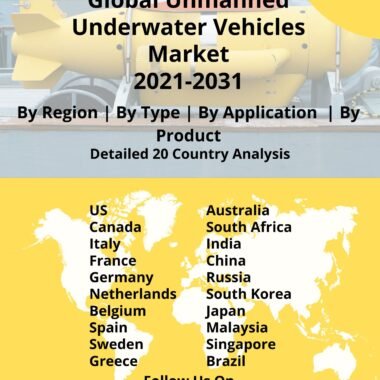Description
Global Anti Submarine Warfare Market
Frequently Asked Questions of ASW Market
Ballistic missiles that are launched from submarines have long been seen as the most impregnable part of the strategic nuclear arsenal used by the US and the USSR. In the millions of cubic miles of ocean where they can go, strategic missile-armed submarines are so difficult to find that they are essentially impervious to a coordinated attack by antisubmarine (ASW) troops. Since it gives the nuclear powers a guaranteed ability to retaliate in the event of a surprise nuclear attack, this invulnerability is essential to the stability of nuclear deterrence.
Anti-submarine warfare market forecast is always being improved, and ASW forces are continuously becoming more capable. ASW operations could be redirected toward the detection, tracking, and destruction of strategic missile-carrying submarines even though they have traditionally been focused on protecting surface ships’ maritime lines of communication against submarine attack. The sonar can be quickly and readily integrated with sensors and battle management systems thanks to COTS technology. Omni and sector transmission, electronic map overlay, sound propagation model, enhanced tracking and detection, as well as an integrated training simulator, are a few of the key features.
The ASW patrol aircraft equipped with a full range of antisubmarine systems and advanced information processing capabilities is a potent weapon in maritime surveillance. In order to combat the perilous submarine menace, air ASW operations started in earnest during World War II. The destruction and terror of World War I earlier on gave the need for efficient ASW forces, particularly aircrafts, and a considerably higher priority. Since World War II, the aircraft and the submarine have been engaged in a fierce chess battle. The submarine threat responds to every new tactical or technological advancement in Air ASW with a new method or system.
Major factors driving Anti Submarine Warfare Market Growth
Anti-submarine warfare systems market size is increasing owing to the increasing territorial disputes between countries. Government, defense industries and military forces are introducing newer and more versatile submarines. which increases the anti-submarine warfare systems market growth. Hence anti-submarine warfare systems market growth is expected to grow with the proliferation of submarines. Procurement of newer ASW aircrafts and helicopters with advanced sensors is also estimated to drive anti-submarine warfare systems market growth.
Trends influencing the Anti Submarine Warfare Market Size
Anti-submarine warfare systems market trends, acoustic and non-acoustic sensors are also known as wet- and dry-end sensors in some international services. The detection power offered by acoustic sensors is enhanced by non-acoustic sensors. These sensors employ electromagnetic systems to intercept submarine radar emissions, infrared receivers to detect the heat signatures of surfaced submarines, radar to detect exposed periscopes and hull surfaces, and magnetic anomaly detectors (MAD) to detect minute shifts in the Earth’s magnetic field brought on by passing submarines.
Anti-submarine warfare systems market trends, modern airborne radar systems must be compact and powerful enough to perform ASW operations, long-range surface vessel detection and surveillance, airborne navigation, and weather avoidance. Many Air ASW radar systems employ various radar frequencies, scanning rates, transmission properties, pulse lengths, and signal processing techniques to achieve this goal. These modifications help to lessen background sea clutter and improve the radar returns from exposed periscopes and submarine hulls. However, the hostile submarine can still identify the radar emissions of ASW aircraft at a considerably wider range than the aircraft can detect the submarine by radar.
Anti-submarine warfare systems market analysis, Electro-Magnetic (EM) sensors actively search the radio frequency spectrum for enemy forces’ deliberate electronic emissions. These electronic emissions come from aircraft, ships, and land-based locations. They can be found from submarines as well. The key distinction is that Air ASW EM sensors offer all the information required to identify and pinpoint the sort of electro-magnetic emission that has been picked up. Anti-submarine warfare systems market analysis, The primary purpose of ASW aircraft’s electromagnetic (EM) equipment is to look for radar signals because the radio-frequency spectrum is so densely populated with both hostile and friendly as well as neutral electronic emissions.
Anti Submarine Warfare Market Forecast & Dynamics
Anti-submarine warfare systems market forecast, the increase in defense spending will encourage procurement of anti-submarine warfare systems and related systems to step up their production volumes and improve their quality, thereby enhancing competition in the global markets. Procurement will also be driven by prevailing geo political conditions in Europe and the Asia Pacific and increasing use of submarines for surveillance and intelligence gathering.
Anti Submarine Warfare Market Analysis for Recent Developments
Anti-submarine warfare systems market reports, In order to prevent US submarines from aiding Taiwan, the Chinese PLA Navy improves its anti-sub warfare capabilities. Being held by the Southern Theatre Command means China’s interest in the South China Sea (SCS) — notably the northern section of the SCS — persists, while the Eastern Theatre Command is the command responsible for a Taiwan crisis (ETC). Anti-submarine warfare systems market reports,, it is safe to presume that the PLAN is aiming for US Navy nuclear-powered submarines (SSNs and SSBNs), which would need to use the Basi Channel and the Luzon Strait to access the uphill slope of the SCS.
The market is navigating the depths of technological innovation and strategic imperatives to counter undersea threats effectively. ASW systems, designed to detect, track, and neutralize hostile submarines, are witnessing heightened demand as maritime nations focus on bolstering their naval capabilities. The market is characterized by the development of advanced sonar technologies, underwater sensors, and anti-submarine weapons, reflecting a commitment to enhancing situational awareness and anti-submarine capabilities. Technological advancements, such as towed and hull-mounted sonar systems, autonomous underwater vehicles (AUVs), and advanced torpedoes, are reshaping the ASW landscape. These innovations enable naval forces to detect and engage submarines with greater precision and efficiency, ensuring the protection of maritime interests and critical sea lanes.
Geopolitical considerations, including regional tensions and the growing submarine capabilities of some nations, are driving investments in ASW capabilities globally. Nations are increasingly recognizing the importance of countering undersea threats to maintain maritime security and dominance. The global Anti-Submarine Warfare market in 2023 signifies a strategic focus on countering undersea threats through cutting-edge technologies. As the maritime domain evolves, the ASW market plays a pivotal role in ensuring the effectiveness and readiness of naval forces against the challenges posed by modern submarine warfare.”
![Global_Anti-Submarine_Warfare_Market_2024-2034[1] Global_Anti-Submarine_Warfare_Market](https://aviationanddefensemarketreports.com/wp-content/uploads/2022/08/Global_Anti-Submarine_Warfare_Market_2024-20341.jpg)






